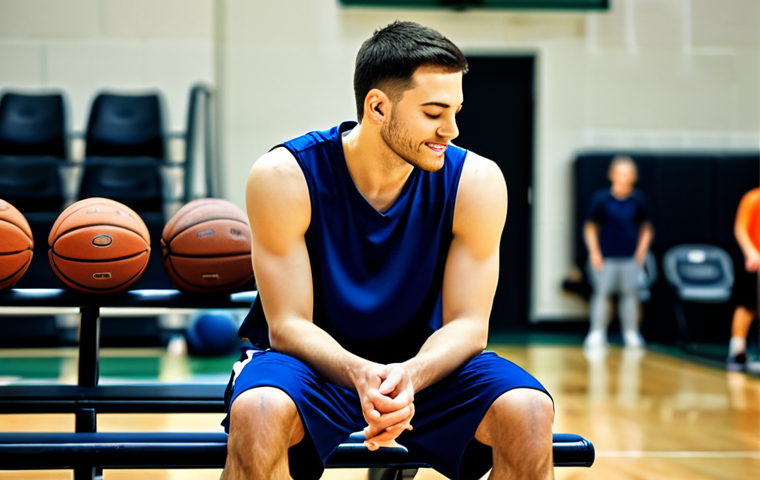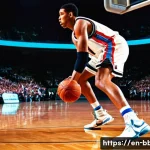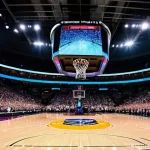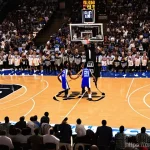Okay, here’s a blog-style introduction about designing a basketball training program:So, you’re serious about leveling up your basketball game? Awesome!
Building a killer training program is key, but where do you even start? It’s not just about endless drills; it’s about crafting a plan that targets your weaknesses and amplifies your strengths.
I’ve spent countless hours tweaking my own routines, and trust me, a well-structured program makes all the difference. Let’s get into the nitty-gritty, so you can start building a training program designed to take you to the next level.
Let’s dive in and learn how to create a basketball training program that will truly make an impact. Let’s get started and find out for sure!
## Fine-Tuning Your Skills: Drill Selection and ExecutionMaking progress in basketball isn’t about blindly repeating drills. It’s about choosing the right ones and performing them with precision.
I remember when I was younger, I’d just go through the motions of dribbling and shooting. It wasn’t until I started focusing on specific aspects of my game that I really saw improvement.
Identifying Your Weak Points

Before you even pick up a ball, take a hard look at your game. What are you struggling with? Is it ball handling under pressure?
Maybe your jump shot isn’t as consistent as you’d like. I use to get so nervous when defenders were closing in, my dribble would fall apart and I’d turn the ball over.
Identifying those weaknesses is the first step. For example, if you’re having trouble with your weak-hand dribbling, focus on drills that specifically target that area.
I found that spending just 15 minutes a day on weak-hand drills made a huge difference in my confidence and control.
Prioritize Quality Over Quantity
It’s easy to fall into the trap of thinking that more is always better. But when it comes to drills, quality trumps quantity every time. Instead of rushing through a bunch of reps, focus on executing each one with perfect form and maximum effort.
Think about it like this: Would you rather shoot 100 sloppy free throws or 25 that are perfectly aligned and focused? I’ve found that when I slow down and concentrate on each rep, I get more out of my training.
Remember, muscle memory is built through repetition, so make sure you’re repeating the right movements.
Building a Personalized Workout Schedule
A random assortment of drills won’t cut it. You need a structured schedule that builds upon itself and keeps you progressing. Think of it like building a house; you need a solid foundation before you can start adding the walls and roof.
Your workout schedule should be designed to address your specific needs and goals, and it should be challenging but also sustainable.
Setting Realistic Goals
Dream big, but start small. If you’re aiming to increase your vertical jump by 6 inches, don’t expect it to happen overnight. Set smaller, more achievable goals along the way, like adding an inch every few weeks.
This will keep you motivated and prevent you from getting discouraged. For instance, I was desperate to dunk, but my vertical was lacking. I started by focusing on exercises that targeted my leg strength and explosiveness, and gradually worked my way up.
Celebrate those small victories along the way. It all adds up!
Balancing Skill Work and Conditioning
You can’t just be a pure shooter or a pure athlete. You need to have a balance of both skill work and conditioning to be effective on the court. Dedicate some time to practicing your shooting form, dribbling moves, and passing accuracy.
But also make sure you’re putting in the work to improve your strength, speed, and endurance. I like to alternate between skill-based drills and conditioning drills to keep things interesting and prevent burnout.
For example, you might spend 30 minutes working on your jump shot, followed by 30 minutes of sprints and plyometrics.
Maximizing Your Training Time: Efficiency is Key
Time is precious, so you need to make the most of every minute you spend in the gym. This means being organized, focused, and efficient. Don’t waste time standing around chatting or scrolling through your phone.
Come prepared with a plan and a purpose, and get to work.
Warm-Up and Cool-Down Routines
Never skip the warm-up! A proper warm-up prepares your body for the stress of training and helps prevent injuries. Spend at least 10-15 minutes doing some light cardio, dynamic stretching, and sport-specific movements.
I like to start with some jogging, followed by arm circles, leg swings, and torso twists. And don’t forget to cool down after your workout. Stretching helps to improve flexibility and reduce muscle soreness.
Using Technology to Track Progress
There are tons of apps and gadgets out there that can help you track your progress and stay motivated. From jump trackers to heart rate monitors, technology can provide valuable insights into your training.
I use a fitness tracker to monitor my activity levels and sleep patterns, and I use a shooting app to track my shooting percentage and accuracy. I was initially hesitant to try these but they really give you a great sense of how much work you are putting in and tangible progress really motivates you to keep going.
Mental Toughness: Training Your Mind
Basketball is just as much a mental game as it is a physical one. You need to be able to stay focused, confident, and resilient, even when things get tough.
That’s why it’s important to incorporate mental training into your overall program.
Visualization Techniques
Visualization is a powerful tool that can help you improve your performance. Before you start a drill, take a few moments to visualize yourself executing it perfectly.
Imagine the ball going through the hoop, the defender getting beat, or the pass hitting your teammate right in the hands. Visualization can help you build confidence and improve your focus.
When I was younger, I used to visualize myself hitting the game-winning shot before every game. It helped me stay calm and focused under pressure.
Dealing with Setbacks and Frustration
Everyone experiences setbacks in their training. You’re going to have days when your shot isn’t falling, your legs feel heavy, or you just can’t seem to get anything right.
It’s important to learn how to deal with these setbacks and not let them derail your progress. The key is to stay positive, keep working hard, and remember that every player experiences ups and downs.
When I hit a slump, I try to focus on the process rather than the outcome. I remind myself that as long as I’m putting in the work and staying focused, the results will eventually come.
Here’s a sample table summarizing key aspects of a well-rounded basketball training program:
| Component | Description | Example Activities | Frequency |
|---|---|---|---|
| Skill Development | Focuses on improving specific basketball skills. | Shooting drills, dribbling exercises, passing practice | 3-4 times per week |
| Strength and Conditioning | Enhances physical strength, speed, and endurance. | Weightlifting, plyometrics, sprint training | 2-3 times per week |
| Mental Training | Improves focus, confidence, and resilience. | Visualization, mindfulness, goal setting | Daily |
| Recovery | Allows the body to rest and repair itself. | Stretching, foam rolling, sleep | Daily |
Nutrition and Recovery: Fueling Your Body
You can’t out-train a bad diet. What you eat has a huge impact on your energy levels, performance, and recovery. Make sure you’re fueling your body with nutritious foods that will help you perform at your best.
This means eating plenty of fruits, vegetables, lean protein, and whole grains.
Hydration Strategies
Staying hydrated is crucial for optimal performance. Dehydration can lead to fatigue, muscle cramps, and decreased performance. Aim to drink plenty of water throughout the day, especially before, during, and after your workouts.
I always carry a water bottle with me and sip on it throughout the day.
Importance of Sleep
Sleep is when your body repairs itself and recovers from training. Aim for at least 7-8 hours of sleep per night. Getting enough sleep can improve your energy levels, mood, and cognitive function.
I know it can be tough to prioritize sleep, especially when you’re busy with school, work, and basketball. But trust me, it’s worth it. When I get enough sleep, I feel like a different person on the court.
Measuring Progress and Making Adjustments
Your training program shouldn’t be set in stone. As you progress, you’ll need to make adjustments to keep challenging yourself and maximizing your results.
This means tracking your progress, analyzing your data, and making changes to your program as needed.
Keeping a Training Journal
A training journal is a great way to track your progress and identify areas for improvement. Write down what you did during each workout, how you felt, and any notable observations.
This will help you see how far you’ve come and identify any patterns or trends in your training. I like to review my training journal every week to see what’s working and what’s not.
Seeking Feedback from Coaches and Teammates
Don’t be afraid to ask for help from your coaches and teammates. They can provide valuable feedback on your game and help you identify areas where you can improve.
I always ask my coach for feedback after games and practices. It helps me see things from a different perspective and identify areas where I can get better.
By implementing these strategies, you’ll be well on your way to building a basketball training program that will take your game to the next level. Remember, it’s all about hard work, dedication, and a commitment to continuous improvement.
Fine-Tuning Your Skills: Drill Selection and ExecutionMaking progress in basketball isn’t about blindly repeating drills. It’s about choosing the right ones and performing them with precision.
I remember when I was younger, I’d just go through the motions of dribbling and shooting. It wasn’t until I started focusing on specific aspects of my game that I really saw improvement.
Identifying Your Weak Points
Before you even pick up a ball, take a hard look at your game. What are you struggling with? Is it ball handling under pressure?
Maybe your jump shot isn’t as consistent as you’d like. I use to get so nervous when defenders were closing in, my dribble would fall apart and I’d turn the ball over.
Identifying those weaknesses is the first step. For example, if you’re having trouble with your weak-hand dribbling, focus on drills that specifically target that area.
I found that spending just 15 minutes a day on weak-hand drills made a huge difference in my confidence and control.
Prioritize Quality Over Quantity
It’s easy to fall into the trap of thinking that more is always better. But when it comes to drills, quality trumps quantity every time. Instead of rushing through a bunch of reps, focus on executing each one with perfect form and maximum effort.
Think about it like this: Would you rather shoot 100 sloppy free throws or 25 that are perfectly aligned and focused? I’ve found that when I slow down and concentrate on each rep, I get more out of my training.
Remember, muscle memory is built through repetition, so make sure you’re repeating the right movements.
Building a Personalized Workout Schedule
A random assortment of drills won’t cut it. You need a structured schedule that builds upon itself and keeps you progressing. Think of it like building a house; you need a solid foundation before you can start adding the walls and roof.
Your workout schedule should be designed to address your specific needs and goals, and it should be challenging but also sustainable.
Setting Realistic Goals
Dream big, but start small. If you’re aiming to increase your vertical jump by 6 inches, don’t expect it to happen overnight. Set smaller, more achievable goals along the way, like adding an inch every few weeks.
This will keep you motivated and prevent you from getting discouraged. For instance, I was desperate to dunk, but my vertical was lacking. I started by focusing on exercises that targeted my leg strength and explosiveness, and gradually worked my way up.
Celebrate those small victories along the way. It all adds up!
Balancing Skill Work and Conditioning
You can’t just be a pure shooter or a pure athlete. You need to have a balance of both skill work and conditioning to be effective on the court. Dedicate some time to practicing your shooting form, dribbling moves, and passing accuracy.
But also make sure you’re putting in the work to improve your strength, speed, and endurance. I like to alternate between skill-based drills and conditioning drills to keep things interesting and prevent burnout.
For example, you might spend 30 minutes working on your jump shot, followed by 30 minutes of sprints and plyometrics.
Maximizing Your Training Time: Efficiency is Key
Time is precious, so you need to make the most of every minute you spend in the gym. This means being organized, focused, and efficient. Don’t waste time standing around chatting or scrolling through your phone.
Come prepared with a plan and a purpose, and get to work.
Warm-Up and Cool-Down Routines
Never skip the warm-up! A proper warm-up prepares your body for the stress of training and helps prevent injuries. Spend at least 10-15 minutes doing some light cardio, dynamic stretching, and sport-specific movements.
I like to start with some jogging, followed by arm circles, leg swings, and torso twists. And don’t forget to cool down after your workout. Stretching helps to improve flexibility and reduce muscle soreness.
Using Technology to Track Progress
There are tons of apps and gadgets out there that can help you track your progress and stay motivated. From jump trackers to heart rate monitors, technology can provide valuable insights into your training.
I use a fitness tracker to monitor my activity levels and sleep patterns, and I use a shooting app to track my shooting percentage and accuracy. I was initially hesitant to try these but they really give you a great sense of how much work you are putting in and tangible progress really motivates you to keep going.
Mental Toughness: Training Your Mind
Basketball is just as much a mental game as it is a physical one. You need to be able to stay focused, confident, and resilient, even when things get tough.
That’s why it’s important to incorporate mental training into your overall program.
Visualization Techniques
Visualization is a powerful tool that can help you improve your performance. Before you start a drill, take a few moments to visualize yourself executing it perfectly.
Imagine the ball going through the hoop, the defender getting beat, or the pass hitting your teammate right in the hands. Visualization can help you build confidence and improve your focus.
When I was younger, I used to visualize myself hitting the game-winning shot before every game. It helped me stay calm and focused under pressure.
Dealing with Setbacks and Frustration
Everyone experiences setbacks in their training. You’re going to have days when your shot isn’t falling, your legs feel heavy, or you just can’t seem to get anything right.
It’s important to learn how to deal with these setbacks and not let them derail your progress. The key is to stay positive, keep working hard, and remember that every player experiences ups and downs.
When I hit a slump, I try to focus on the process rather than the outcome. I remind myself that as long as I’m putting in the work and staying focused, the results will eventually come.
Here’s a sample table summarizing key aspects of a well-rounded basketball training program:
| Component | Description | Example Activities | Frequency |
|---|---|---|---|
| Skill Development | Focuses on improving specific basketball skills. | Shooting drills, dribbling exercises, passing practice | 3-4 times per week |
| Strength and Conditioning | Enhances physical strength, speed, and endurance. | Weightlifting, plyometrics, sprint training | 2-3 times per week |
| Mental Training | Improves focus, confidence, and resilience. | Visualization, mindfulness, goal setting | Daily |
| Recovery | Allows the body to rest and repair itself. | Stretching, foam rolling, sleep | Daily |
Nutrition and Recovery: Fueling Your Body
You can’t out-train a bad diet. What you eat has a huge impact on your energy levels, performance, and recovery. Make sure you’re fueling your body with nutritious foods that will help you perform at your best.
This means eating plenty of fruits, vegetables, lean protein, and whole grains.
Hydration Strategies
Staying hydrated is crucial for optimal performance. Dehydration can lead to fatigue, muscle cramps, and decreased performance. Aim to drink plenty of water throughout the day, especially before, during, and after your workouts.
I always carry a water bottle with me and sip on it throughout the day.
Importance of Sleep
Sleep is when your body repairs itself and recovers from training. Aim for at least 7-8 hours of sleep per night. Getting enough sleep can improve your energy levels, mood, and cognitive function.
I know it can be tough to prioritize sleep, especially when you’re busy with school, work, and basketball. But trust me, it’s worth it. When I get enough sleep, I feel like a different person on the court.
Measuring Progress and Making Adjustments
Your training program shouldn’t be set in stone. As you progress, you’ll need to make adjustments to keep challenging yourself and maximizing your results.
This means tracking your progress, analyzing your data, and making changes to your program as needed.
Keeping a Training Journal
A training journal is a great way to track your progress and identify areas for improvement. Write down what you did during each workout, how you felt, and any notable observations.
This will help you see how far you’ve come and identify any patterns or trends in your training. I like to review my training journal every week to see what’s working and what’s not.
Seeking Feedback from Coaches and Teammates
Don’t be afraid to ask for help from your coaches and teammates. They can provide valuable feedback on your game and help you identify areas where you can improve.
I always ask my coach for feedback after games and practices. It helps me see things from a different perspective and identify areas where I can get better.
By implementing these strategies, you’ll be well on your way to building a basketball training program that will take your game to the next level. Remember, it’s all about hard work, dedication, and a commitment to continuous improvement.
Wrapping Up
So, there you have it – a comprehensive guide to building a basketball training program that’s tailored to you. Remember, consistency is key, and it’s okay to adjust your plan as you grow and evolve. Embrace the journey, stay disciplined, and watch your game soar. See you on the court!
Things to Keep in Mind
1. Invest in good quality basketball shoes to prevent injuries and enhance your performance on the court.
2. Proper warm-up routines are crucial to prepare your body for the demands of training and reduce the risk of strains or sprains.
3. Learn to manage your time effectively to balance basketball training with other commitments like school, work, and personal life.
4. Set small, achievable goals regularly to maintain motivation and track progress in your training.
5. Engage in regular active recovery activities like stretching or light cardio to alleviate muscle soreness and promote faster recovery.
Key Takeaways
Building a great basketball training program involves more than just shooting hoops. It’s about identifying your weaknesses, setting realistic goals, balancing skill work with conditioning, maximizing your training time, and training your mind.
Also, don’t forget the importance of nutrition and recovery. By following these strategies, you’ll be well on your way to taking your game to the next level.
Frequently Asked Questions (FAQ) 📖
Q: I’m super busy! How long should a basketball training session typically last to still be effective?
A: I get it, life’s hectic! Honestly, you don’t need to spend hours in the gym. A focused 60-90 minute session can be incredibly effective.
I’ve found that anything longer than that and my intensity starts to drop off, and that’s when injuries happen. Focus on quality over quantity, warm up properly, hit your key drills with high intensity, and then cool down.
Short, sharp, and consistent is the key. I used to think I had to grind for three hours straight, but I saw much better results (and felt way less burnt out!) when I shortened the sessions and really concentrated on giving it my all during that time.
Think of it like a power nap for your game!
Q: I’m not a pro, just playing in a rec league. Do I really need a structured training program? Seems a bit overkill.
A: Haha, I totally understand the sentiment! “Overkill” is exactly what my buddy Mark said before he started using a program I helped him build. Look, you don’t need to train like LeBron James, but having a plan definitely elevates your game.
It’s about being smart, not just running around aimlessly. A structured program can help you identify your weaknesses, focus your training, and ultimately, see real improvements.
Think of it like this: you wouldn’t try to bake a cake without a recipe, right? Plus, even a basic program will significantly reduce your risk of injury because you are focusing on things like warmups and targeted muscle exercises.
I’ve seen too many guys tweak ankles or pull muscles because they just jumped into games cold. Believe me, a little planning goes a long way, even in a rec league.
Q: What if I don’t have access to a fancy gym or a personal trainer? Can I still create an effective training program?
A: Absolutely! You don’t need all the bells and whistles of a pro facility. That’s a misconception.
Bodyweight exercises, a basketball, a hoop (even a public park one!), and some open space are your best friends. Think plyometrics, cone drills for agility, shooting practice, and core work.
My buddy, Sarah, transformed her game using nothing but a driveway hoop and online resources. The key is to be resourceful and creative. YouTube is packed with free workouts, and you can adapt most drills to your environment.
Seriously, don’t let the lack of equipment hold you back. A little ingenuity and consistent effort are all you need. You can even use household items for some of the exercises – think water bottles for weights!
📚 References
Wikipedia Encyclopedia






